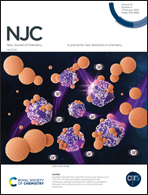New nickel(ii) Schiff base complexes as potential tools against SARS-CoV-2 Omicron target proteins: an in silico approach†
Abstract
Herein, we report the in silico design and synthesis of two new nickel(II) coordination complexes, viz., [Ni(L1)][(PPh3)]DMF (1) and [Ni(L2)] (2), based on Schiff bases derived from the 2-hydroxy-1-naphthaldehyde moiety (where, L1H2 = (E)-3-(((5-chloro-2-hydroxyphenyl)imino)methyl)naphthalene-2-ol), (L2H2 = 2,2′-((1E,1′E)-(ethane-1,2-diylbis(azaneylylidene))bis(methaneylylidene))bis(naphthalen-2-ol)), PPh3 = (triphenylphosphine). The synthesized ligands L1H2 and L2H2 were coordinated to Ni(II) ions through the tridentate-ONO and tetradentate-N2O2 donor atoms, respectively. The newly synthesized complexes were fully characterized using X-ray crystallography analysis. The synthesized complexes (1) and (2) crystallized in the triclinic and monoclinic crystal system with the P![[1 with combining macron]](https://www.rsc.org/images/entities/char_0031_0304.gif) and P21/c space group, respectively, and exhibited a square planar geometry around the Ni(II) ions. Computational approaches were employed to determine the structure–property relationship of the complexes. Hirshfeld surface analysis was also performed to investigate intermolecular interactions in the crystal systems. The strength of the interaction and 3D topology of crystal packing were visualized through an energy framework. To gain insights into the potential application of Ni(II) complexes as effective SARS-CoV-2 Omicron inhibitors, we performed the following docks (a) Ni(II) complexes with S protein from original SARS-CoV-2 (PDB ID: 7CWO), (b) Ni(II) complexes with selected Omicron targets (PDB ID: 7QTK and 7WK8) and (c) controls ivermectin and levosalbutamol with the original SARS-CoV-2 spike protein and the Omicron S proteins. The synthesized Ni(II) complexes (1) and (2) showed good docking results with the S protein of SARS-CoV-2, where the binding energies (ΔG) and respective Ki (inhibition constants) correlation values are −7.38 (3.87 μM) and −8.82 (341.77 nM), respectively. The molecular docking results revealed that the synthesized complexes (1) and (2) with the SARS-CoV-2 Omicron target protein (PDB ID: 7QTK) resulted the binding energy (ΔG) of −7.46 kcal mol−1 with an inhibition constant (Ki) of 3.39 μM and binding energy (ΔG) of −7.56 kcal mol−1 with an inhibition constant (Ki) of 2.89 μM, respectively. Similarly, the synthesized Ni(II) complexes (1) and (2) with the SARS-CoV-2 Omicron target protein (PDB ID: 7WK8) exhibited the binding energy (ΔG) and inhibition constant (Ki) of −7.03 kcal mol−1 and 7.08 μM and −7.89 kcal mol−1 and 1.64 μM, respectively. It was predicted that ivermectin shows a larger binding energy (ΔG) for S proteins compared to levosalbutamol after molecular docking. Further, in silico ADMET to predict the drug-likeness behaviour and pharmacokinetic response of the synthesized complexes was also explored. Overall, the present study suggests that nickel(II) complexes can be considered as potential therapeutic drugs against the Omicron target protein of SARS-CoV-2.
and P21/c space group, respectively, and exhibited a square planar geometry around the Ni(II) ions. Computational approaches were employed to determine the structure–property relationship of the complexes. Hirshfeld surface analysis was also performed to investigate intermolecular interactions in the crystal systems. The strength of the interaction and 3D topology of crystal packing were visualized through an energy framework. To gain insights into the potential application of Ni(II) complexes as effective SARS-CoV-2 Omicron inhibitors, we performed the following docks (a) Ni(II) complexes with S protein from original SARS-CoV-2 (PDB ID: 7CWO), (b) Ni(II) complexes with selected Omicron targets (PDB ID: 7QTK and 7WK8) and (c) controls ivermectin and levosalbutamol with the original SARS-CoV-2 spike protein and the Omicron S proteins. The synthesized Ni(II) complexes (1) and (2) showed good docking results with the S protein of SARS-CoV-2, where the binding energies (ΔG) and respective Ki (inhibition constants) correlation values are −7.38 (3.87 μM) and −8.82 (341.77 nM), respectively. The molecular docking results revealed that the synthesized complexes (1) and (2) with the SARS-CoV-2 Omicron target protein (PDB ID: 7QTK) resulted the binding energy (ΔG) of −7.46 kcal mol−1 with an inhibition constant (Ki) of 3.39 μM and binding energy (ΔG) of −7.56 kcal mol−1 with an inhibition constant (Ki) of 2.89 μM, respectively. Similarly, the synthesized Ni(II) complexes (1) and (2) with the SARS-CoV-2 Omicron target protein (PDB ID: 7WK8) exhibited the binding energy (ΔG) and inhibition constant (Ki) of −7.03 kcal mol−1 and 7.08 μM and −7.89 kcal mol−1 and 1.64 μM, respectively. It was predicted that ivermectin shows a larger binding energy (ΔG) for S proteins compared to levosalbutamol after molecular docking. Further, in silico ADMET to predict the drug-likeness behaviour and pharmacokinetic response of the synthesized complexes was also explored. Overall, the present study suggests that nickel(II) complexes can be considered as potential therapeutic drugs against the Omicron target protein of SARS-CoV-2.



 Please wait while we load your content...
Please wait while we load your content...